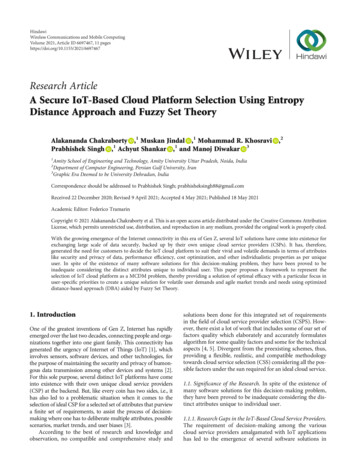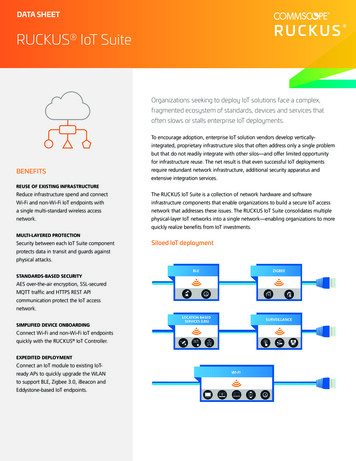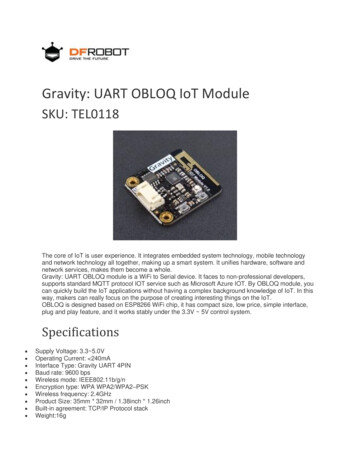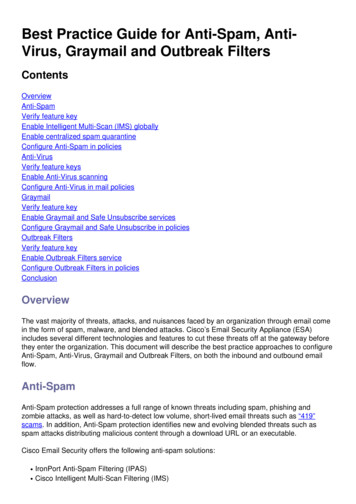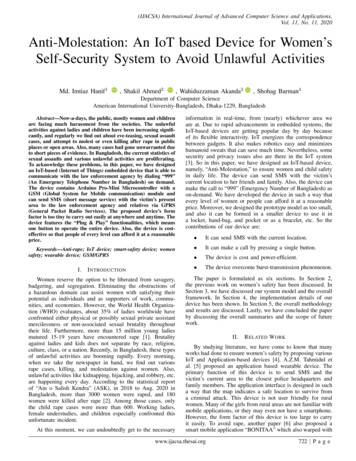
Transcription
(IJACSA) International Journal of Advanced Computer Science and Applications,Vol. 11, No. 11, 2020Anti-Molestation: An IoT based Device for Women’sSelf-Security System to Avoid Unlawful ActivitiesMd. Imtiaz Hanif1ID, Shakil Ahmed2ID, Wahiduzzaman Akanda3ID, Shohag Barman4Department of Computer ScienceAmerican International University-Bangladesh, Dhaka-1229, BangladeshAbstract—Now-a-days, the public, mostly women and childrenare facing much harassment from the societies. The unlawfulactivities against ladies and children have been increasing significantly, and regularly we find out about eve-teasing, sexual assaultcases, and attempt to molest or even killing after rape in publicplaces or open areas. Also, many cases had gone unwarranted dueto short pieces of evidence. In Bangladesh, the current statistics ofsexual assaults and various unlawful activities are proliferating.To acknowledge these problems, in this paper, we have designedan IoT-based (Internet of Things) embedded device that is able tocommunicate with the law enforcement agency by dialing “999”(An Emergency Telephone Number in Bangladesh) on demand.The device contains Arduino Pro-Mini Microcontroller with aGSM (Global System for Mobile communication) module andcan send SMS (short message service) with the victim’s presentarea to the law enforcement agency and relatives via GPRS(General Packet Radio Services). The proposed device’s formfactor is too tiny to carry out easily at anywhere and anytime. Thedevice features the “Plug & Play” functionalities, which meansone button to operate the entire device. Also, the device is costeffective so that people of every level can afford it at a reasonableprice.Keywords—Anti-rape; IoT device; smart-safety device; womensafety; wearable device; GSM/GPRSI.I NTRODUCTIONWomen reserve the option to be liberated from savagery,badgering, and segregation. Eliminating the obstructions ofa hazardous domain can assist women with satisfying theirpotential as individuals and as supporters of work, communities, and economies. However, the World Health Organization (WHO) evaluates, about 35% of ladies worldwide haveconfronted either physical or possibly sexual private assistantmercilessness or non-associated sexual brutality throughouttheir life. Furthermore, more than 15 million young ladiesmatured 15-19 years have encountered rape [1]. Brutalityagainst ladies and kids does not separate by race, religion,culture, class, or a nation. Recently, in Bangladesh, these typesof unlawful activities are booming rapidly. Every morning,when we take the newspaper in hand, we find out variousrape cases, killing, and molestation against women. Also,unlawful activities like kidnapping, hijacking, and robbery, etc.are happening every day. According to the statistical reportof “Ain o Salish Kendra” (ASK), in 2018 to Aug. 2020 inBangladesh, more than 3000 women were raped, and 180women were killed after rape [2]. Among those cases, onlythe child rape cases were more than 600. Working ladies,female understudies, and children especially confronted thisunfortunate incident.At this moment, we can undoubtedly get to the necessaryinformation in real-time, from (nearly) whichever area weare at. Due to rapid advancements in embedded systems, theIoT-based devices are getting popular day by day becauseof its flexible interactivity. IoT energizes the correspondencebetween gadgets. It also makes robotics easy and minimizeshumanoid sweats that can save much time. Nevertheless, somesecurity and privacy issues also are there in the IoT system[3]. So in this paper, we have designed an IoT-based device,namely, “Anti-Molestation,” to ensure women and child safetyin daily life. The device can send SMS with the victim’scurrent location to her friends and family. Also, the device canmake the call to “999” (Emergency Number of Bangladesh) ason-demand. We have developed the device in such a way thatevery level of women or people can afford it at a reasonableprice. Moreover, we designed the prototype model as too small,and also it can be formed in a smaller device to use it ina locket, hand-bag, and pocket or as a bracelet, etc. So thecontributions of our device are: It can send SMS with the current location. It can make a call by pressing a single button. The device is cost and power-efficient. The device overcome burst-transmission phenomenon.The paper is formulated as six sections. In Section 2,the previous work on women’s safety has been discussed. InSection 3, we have discussed our system model and the overallframework. In Section 4, the implementation details of ourdevice has been shown. In Section 5, the overall methodologyand results are discussed. Lastly, we have concluded the paperby discussing the overall summaries and the scope of futurework.II.R ELATED W ORKBy studying literature, we have come to know that manyworks had done to ensure women’s safety by proposing variousIoT and Application-based devices [4]. A.Z.M. Tahmidul etal. [5] proposed an application based wearable device. Theprimary function of this device is to send SMS and thevictim’s current area to the closest police headquarters andfamily members. The application interface is designed in sucha way that the map indicates a safe location to survive froma criminal attack. This device is not user friendly for ruralwomen. Many of the girls from rural areas are not familiar withmobile applications, or they may even not have a smartphone.However, the form factor of this device is too large to carryit easily. To avoid rape, another paper [6] also proposed asmart mobile application “BONITAA” which also warped withwww.ijacsa.thesai.org722 P a g e
(IJACSA) International Journal of Advanced Computer Science and Applications,Vol. 11, No. 11, 2020various features such as SMS and location sending via GSM,health supports, medical supports, counseling, self-defensetips for the rape victims. To acknowledge the problem ofrural women, they integrated the “Bangla” language in theirapplication and tried to make it user friendly. However, theproblem is that the women who are not familiar with usingmobile applications may not relish the facilities of thoseapplications.The author in [7] proposed a wearable device to ensurewomen’s safety to avoid sexual assault. The method alsointroduced a mobile application. They designed their deviceusing GSM, GPS (Global Positioning System), and the Wi-Fi(Wireless Fidelity) module integrated with a Microcontroller.The device is also able to make the call and send the locationto the pre-recorded numbers or the nearest police stationsto avoid unlawful activities. The main problem is that thedevice needs the always-on internet for web server access.They spent a lot on building such a device with a mobileapplication. It can not be affordable for every woman in oursociety, and also the application-based interface is not flexiblefor all end users. In the paper [8], the author also proposeda women safety device. The device also can send SMS andlocation to the pre-saved phone numbers. To avoid sexualmanipulations, the authors integrated three push-buttons, GSM,GPS, RFID (Radio-Frequency Identification), vibrator, buzzer,and display with a Microcontroller. The main problem is thattheir prototype model is too large to carry. The device alsocontains three switches, which are very difficult to navigatethrough those switches in a panic situation.U. Rai et al. [9] developed a safety device using RaspberryPi with a GPS module and a push button. When a girl pressesthe push button, the device sends its longitude and latitude viaa GPS module. They also developed their location finder application to identify the victim’s location. The prototype is simplebut large in size. Raspberry-Pi needs the always-on internet tocapture the location’s coordinates. N. R. Sogi et al. [10] alsoproposed a Raspberry-Pi based IoT device. They called theirdevice as ”SMARISA” smart ring for women’s safety. Thedevice also can send the location, and additionally, it contains acamera module. When a woman presses the button, the deviceis activated, and the camera module captures the incident andupload images in the local-host server and generate soundwith the buzzer. They also developed a mobile application tocommunicate with the victim’s trusted one. The problem ofthis device is that no GSM module was not considered, andcostly to develop such devices. Moreover, “Raspberry-Pi”, amini-computer, is also power-hungry. Various sensors, suchas pulse rate, motion, and temperature sensor, etc. are usedin [13], [14], [18]. Those devices might not work correctlybecause of integration of various sensors in one module. Thesensors may generate wrong readings in any situation that canactivate the device. The form factors of those devices are alsotoo large to carry. Another device [11] developed to help thevictims from the teaser and molester. The device also sendsthe SMS and current location to the family members of thevictim. Sensor-based devices are not efficient to use becauseof its fault result generation.T. Sen et al. [12] developed a women’s safety device withRaspberry-Pi. The device contains a monumental architecturewith its camera module nerve simulator. The device can sendthe victim’s location via GPS and GSM module. The authorsalso developed an android application and local server tomaximize women’s security. Nevertheless, the problem is thatthe device is too big and can not be carried out easily. V.Sharma et al. [15] also developed a smart shoe to ensurewomen’s safety. The authors used Raspberry-Pi and ArduinoUno Microcontrollers to implement their system. First of all, ashoe base video capturing devices are not efficient to capturecorrect frames. Besides, the use of Arduino Microcontrollerrather than Raspberry-Pi is inadequate in this case. Also, theshock generation of 400KV can kill a human within someminutes. Another work [16] was proposed for supporting thewomen in danger. The device is also designed to send SMS andlocation to relatives of the victim. The device is too huge withits AAA size batteries and the large LCD screen. M. R. Rumanet al. [17] also developed a safety device for women’s safety.The device is also able to send the location of the victim andcan be rescued early. The device contains a shock generatoralso. Integration of various extra facilities, the prototype is toolarge to carry.To acknowledge these problems, we have also built oursafety device to support the women and child. The device is sotiny and can be carried out efficiently in daily life. Moreover,our device is very much cost efficient that people of all levelscan afford it at a reasonable price. The device also has thefeature of “Plug & Play”. So, one operational button to activatethe device for all functionalities.III.F RAMEWORK AND S YSTEM D ESIGNIn this section, we have discussed the overall framework ofour “Anti-Molestation” safety device. The framework containstwo types of system design.A. Working FrameworkAt first, we turn on the device, and when the system isstarted, it will initialize the SIM800L module. Then the GPRSand GSM module will ready to read the data from the userwhen we press the button once it obtains the Geo-Coordinateof the current location via GPRS. Then the system sendsthe HTTP (Hypertext Transfer Protocol) POST request usingthe “AT” attention command along with the Geo-Coordinatelocation to the associated application server. Then the application server sends the Geo-Coordinate location to the prestored phonebook of the victim’s relatives and “999” via SMSgateway. When we long-press the panic button, the systemis ready to call the pre-saved emergency phone number, or“999” on demand. Here, Fig. 1 illustrates the overall workingframework of our proposed “Anti-Molestation” safety system.www.ijacsa.thesai.org723 P a g e
(IJACSA) International Journal of Advanced Computer Science and Applications,Vol. 11, No. 11, 2020Fig. 1. The Working Framework for our Anti-Molestation Safety Device.Here, “999” is the Bangladeshi Emergency Telephone Number, and the ”AT”Denotes the Attention Command to Send Location via Geo-Coordinate.(a) Arduino Pro-Mini.(b) SIM800L Module.(c) Panic Button.(d) 3.7V Battery.(e) Microphone.(f) Speaker.B. Block Diagram and ComponentsThe square diagram of the framework in Fig. 2 illustratesoverall hardware required for developing the gadget.Fig. 2. The Block Diagram of our Device. The Block Diagram shows all theHardware we have used to Develop our Safety Device.(g) Resistance.The main heart of this device is the Arduino Pro-MiniMicro-controller to handle the entire mechanisms. A localhost server is proposed for keeping the truck of every SMSand deliver it to the adjacent police stations. A power supplyis needed to power up the device. We have used Li-Poly(Lithium-Polymer) battery as a power supply. The block diagram also contains a panic button to operate the entire device.A SIM800L module has been used for taking advantage ofthe GPRS and GSM functionalities. We have used a condensermicrophone and a speaker to communicate with the pre-savedemergency numbers. All those components are integrated withthe Arduino Pro-Mini Microcontroller.Fig. 3. The figure shows the Necessary Components that we have used forDeveloping “Anti-Molestation” Safety Device.1) Microcontroller: A Microcontroller (Fig. 3a) is a minimized incorporated circuit proposed to oversee a specificactivity in a rather system. AA normal microcontroller fusesa processor, memory, and I/O (Input-Output) peripherals ona single chip. Here, we have used an Arduino Pro-MiniMicrocontroller, which is too small and can handle all thewww.ijacsa.thesai.org724 P a g e
(IJACSA) International Journal of Advanced Computer Science and Applications,Vol. 11, No. 11, 2020things we need.2) SIM800L Module: We have used SIM800L GSM/GPRSmodule (Fig. 3b) for calling and sending SMS functionalities.The module is attached to the Microcontroller. This module hasa small form factor, and a Subscriber Identify Module (SIM)is attached to it.3) Panic Button: We have used a panic-button (Fig. 3c) toperform “Plug & Play” features. The panic-button regulatestwo functionalities like single press and long-press.4) Power Supply: We have used a 3.7V Lithium-Polymer(Li-Poly) rechargeable battery (Fig. 3d) to power the device.We used this because of its small dimensions. Also, a chargingport is included to charge the device.5) Condenser Microphone and Speaker: We have used acondenser microphone (Fig. 3e) and a speaker (Fig. 3f) totransmit the voice through the safety device so that the lawenforcement agency can hear the sounds around the prey.6) Resistance and Some wires: We used a 10KΩ resistance(Fig. 3g) for voltage regularization. Moreover, some wireswere used for making connections to the entire peripherals.IV.I MPLEMENTATION D ETAILSIn this section, we have discussed the step by step procedure of the overall hardware implementation of our safetydevice. Here, Fig. 4 illustrates the circuit diagram of our safetysystem.The SIM TXD is the transmitter pin and connects with theMicrocontroller’s Master Out Slave In (MOSI) pin for sendingdata to the peripherals. We have used a rechargeable 3.7V Lipoly battery to power up the whole device.TABLE I. T HE COST DISTRIBUTION OF USED COMPONENTS . W ECALCULATE THE COST BOTH IN US D OLLAR AND BANGLADESHI TAKA .Product NamePrice(USD)Price(BDT)Arduino Pro-Mini1.562SIM800L1.57134Panic Button0.022Li-poly Battery1.0993Condenser Mic.0.098Speaker0.02210KΩ Resistor0.055Total (approx.)4.40 USD377 BDTThe positive wire of the battery is connected with theMicrocontroller’s VCC pin, and the negative wire is connectedto the GND pin. The Microcontroller has the Master In SlaveOut (MISO), and RAW pins are serially connected with theswitch S1 to on-off the device. A 10KΩ resistor is also used forthe voltage regulator. The SIM800L module has the MIC pin toconnect the condenser microphone and the SPK pin to connectthe speaker. To build this device, we have spent some money tobuy the necessary components. The total cost of developing the“Anti-Molestation” safety device is approximately 400 BDTor 4.42 USD. Here, Table 1 shows the cost distribution of ournecessary components.The pictorial view of Fig. 5 illustrates the overall viewof the Anti-Molestation safety device. Fig. 5a shows thedissection view of the entire device and Fig. 5b shows thedeveloped view of the device.Fig. 4. The Circuit Diagram of the Device. Here, S1, R1, and U1 denotesthe Switch, Resistance and Battery, Individually.(a) Dissection View.(b) Developed View.Fig. 5. The Developed Form Factor of the Anti-Molestation Device.First of all, we need the Arduino Pro-Mini Microcontrollerto connect all peripherals because it is the heart and only onething that can operate all other hardware. Here, in Fig. 4, wecan see that SIM800L has several pins and the SIM RXDpin connects with Arduino’s digital Input-Output (I/O) 10 pinfor serial communication. The SIM RXD is the receiver pin.V.R ESULTIn this section, we have discussed the methodology andresult of our Anti-Molestation safety device. When a preywww.ijacsa.thesai.org725 P a g e
(IJACSA) International Journal of Advanced Computer Science and Applications,Vol. 11, No. 11, 2020presses the panic button, the SIM800L module call to the“999” law enforcement agency number through the cell phonetower, and by GPRS technology, the device sends SMS withhis/her current location and update it in the application server.The authority notifies the nearby police station to rescuethe prey. Fig. 5b illustrates the form factor of our devicewhich is too small in size to carry anywhere easily. Thedevice can send location continuously. If the law enforcementagency or police try to make a call to the device number, thedevice automatically discard the call and again send SMS withvictim’s current location. Here, Fig. 6a, 6b, and 6c shows thecalling mechanism, location sending mechanism, and locationtraced in map of our safety device accordingly. Moreover, ourdevice is so much power and cost efficient. The device runs along with a single hour charge. Our safety device has shown asignificant result among previous devices with the small formfactor.(a) Making Call.harassed in any situation. The device can directly inform lawenforcement agencies to take legal actions against the culprits.Also, the device can send the victim’s current position to thenearest police station to rescue the victim.The device is so much user-friendly, and people of alllevels can use it without any hassle at a low cost. Eventhough we have built a sophisticated system, we still have somelimitations finding the victim’s actual location. Location canbe distorted up to 100 meters radius from the victim’s positionwhere he/she presses the button. We are trying to overcomethis issue as soon as possible. Moreover, we will also give ourproduct an aesthetic look so that we can take it to the massproduction level quickly.R EFERENCES[1]”Violence against women.” /violence-against-women (accessed Sep. 12, 2020) violence-againstwomen-statistics/rape/ (accessed Sep. 12, 2020) [online].[3]P. Brous, M. Janssen, and P. Herder, ”The dual effects of the Internetof Things (IoT): A systematic review of the benefits and risks ofIoT adoption by organizations,” International Journal of InformationManagement, vol. 51. Elsevier Ltd, p. 101952, Apr. 01, 2020, DOI:10.1016/j.ijinfomgt.2019.05.008.[4]R. Ramachandiran, L. Dhanya, and M. Shalini, ”A survey on womensafety device using IoT,” 2019 IEEE Int. Conf. Syst. Comput. Autom. Networking, ICSCAN, 2019, pp. 1–6, 2019, DOI: 10.1109/ICSCAN.2019.8878817.[5]A. Z. M. Tahmidul Kabir, A. M. Mizan, and T. Tasneem, ”SafetySolution for Women Using Smart Band and CWS App,” pp. 566–569,2020, DOI: 10.1109/ecti-con49241.2020.9158134.[6]S. R. Mahmud, S. N. Tumpa, A. B. Islam, C. N. Ferdous, N. Paul, andT. T. Anannya, ”BONITAA: A smart approach to support the femalerape victims,” 5th IEEE Reg. 10 Humanit. Technol. Conf. 2017, R10HTC, 2017, vol. 2018-January, pp. 730–733, 2018, DOI: 10.1109/R10HTC.2017.8289061.[7]M. N. Islam et al., ”SAFeBanD: A wearable device for the safety ofwomen in Bangladesh,” ACM Int. Conf. Proceeding Ser., pp. 76–83,2018, DOI: 10.1145/3282353.3282363.[8]S. Priyanka, Shivashankar, K. P. Roshini, S. P. Reddy, and K. Rakesh,”Design and implementation of SALVUS women safety device,” 20183rd IEEE Int. Conf. Recent Trends Electron. Inf. Commun. Technol.RTEICT 2018 - Proc., pp. 2438–2442, 2018, DOI: 10.1109/RTEICT42901.2018.9012442.[9]U. Rai, K. Miglani, A. Saha, B. Sahoo, and M. Vergin Raja Sarobin,”ReachOut Smart Safety Device,” 2018 6th Ed. Int. Conf. Wirel.Networks Embed. Syst. WECON 2018 - Proc., pp. 131–134, 2018,DOI: 10.1109/WECON.2018.8782071.[10]N. R. Sogi, P. Chatterjee, U. Nethra, and V. Suma, ”SMARISA: ARaspberry Pi Based Smart Ring for Women Safety Using IoT,” Proc.Int. Conf. Inven. Res. Comput. Appl. ICIRCA, 2018, no. Icirca, pp.451–454, 2018, DOI: 10.1109/ICIRCA.2018.8597424.[11]S. K. Punjabi, S. Chaure, U. Ravale, and D. Reddy, ”Smart IntelligentSystem for Women and Child Security,” 2018 IEEE 9th Annu. Inf.Technol. Electron. Mob. Commun. Conf. IEMCON, 2018, no. Apr9600, pp. 451–454, 2019, DOI: 10.1109/IEMCON.2018.8614929.[12]T. Sen, A. Dutta, S. Singh, and V. N. Kumar, ”ProTecht - Implementation of an IoT based 3 -Way Women Safety Device,” Proc. 3rd Int. Conf.Electron. Commun. Aerosp. Technol. ICECA, 2019, pp. 1377–1384,2019, DOI: 10.1109/ICECA.2019.8821913.[13]K. Thamaraiselvi, S. Rinesh, L. Ramaparvathy, and V. Karthick, ”Internet of Things (IOT) based smart band to ensure the security for women,”Proc. 2nd Int. Conf. Smart Syst. Inven. Technol. ICSSIT 2019, no. Icssit,pp. 1093–1096, 2019, DOI: 10.1109/ICSSIT46314.2019.8987928.(b) Sending Location.(c) Location in Map.Fig. 6. The Qualitative Result of our Safety Device which can make a Call,send SMS with Location.VI.C ONCLUSIONIn this paper, we have proposed and illustrated our device,namely, “Anti-Molestation”, an IoT-based safety device. Thissafety device aims to help women and children from beingwww.ijacsa.thesai.org726 P a g e
(IJACSA) International Journal of Advanced Computer Science and Applications,Vol. 11, No. 11, 2020[14][15][16]M. R. Tejonidhi, Aishwarya, K. Chaithra, M. K. Dayana, and H.Nagamma, ”IoT Based Smart Security Gadget for Women’s Safety,” 1stIEEE Int. Conf. Adv. Inf. Technol. ICAIT 2019 - Proc., pp. 348–352,2019, DOI: 10.1109/ICAIT47043.2019.8987242.V. Sharma, Y. Tomar, and D. Vydeki, ”Smart Shoe for Women Safety,”2019 IEEE 10th Int. Conf. Aware. Sci. Technol. iCAST 2019 - Proc.,pp. 1–4, 2019, DOI: 10.1109/ICAwST.2019.8923204.N. Islam, M. R. Hossain, M. Anisuzzaman, A. J. M. Obaidullah, andS. S. Islam, ”Design and Implementation of Women Auspice Systemby Utilizing GPS and GSM,” 2nd Int. Conf. Electr. Comput. Commun.Eng. ECCE, 2019, pp. 1–6, 2019, DOI: 10.1109/ECACE.2019.8679202.[17] M. R. Ruman, J. K. Badhon and S. Saha, ”Safety Assistant AndHarassment Prevention For Women,” 2019 5th International Conferenceon Advances in Electrical Engineering (ICAEE), Dhaka, Bangladesh,2019, pp. 346-350, DOI: 10.1109/ICAEE48663.2019.8975648.[18] V. Hyndavi, N. S. Nikhita, and S. Rakesh, ”Smart Wearable Devicefor Women Safety Using IoT,” no. Icces, pp. 459–463, 2020, sai.org727 P a g e
Md. Imtiaz Hanif1 ID, Shakil Ahmed2 ID, Wahiduzzaman Akanda3 ID, Shohag Barman4 Department of Computer Science American International University-Bangladesh, Dhaka-1229, Bangladesh Abstract—Now-a-days, the public, mostly women and children are facing much harassment from the societies. The unlawful
